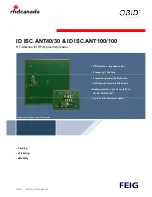
TIP670 User Manual Issue 1.3
Page 11 of 19
5 Functional Description
5.1 Digital Inputs
5.1.1 Optical
Isolation
The TIP670 has 8 (TIP670-10) or 4 (TIP670-20) digital inputs. The standard signal level for these
inputs is 24V DC. The switching level of the inputs is between 8 and 13 volts. All input channels are
isolated by AC optocoupler and are also isolated against each other. The use of AC optocoupler
makes the operation of the inputs independent from signal polarity.
5.1.2 Digital
Filtering
A digital filter circuit is provided for input switch debouncing. The debounce time is adjusted by a
capacitor to approximately 12ms.
5.1.3 Input and Interrupt Logic
The input and interrupt logic is implemented in the Z8536 port controller circuit. The digitally filtered
input signals are connected with port B of the Z8536.
Interrupt generation can be individually programmed for each channel and input transition. For more
detailed information see the Z8536 data manual which is part of the TIP670-ED Engineering
Documentation.
A software initialization of the Z8536 is required before the input states can be read at port B.
5.2 Digital Outputs
5.2.1 Optical
Isolation
The TIP670 has 8 (TIP670-10) or 4 (TIP670-20) digital outputs. The standard signal level for these
outputs is 24V DC. All output channels are isolated by optocoupler and are also isolated against each
other in groups of two outputs.
5.2.2 Output
Polarity
Each output can be individually configured as a high or a low side switch depending on the external
wiring of the output signal lines.
5.2.3 Overload
Protection
The output drivers are implemented by smart drivers TDExxx. The maximum continuous output
current is 0.5A. The output circuits are protected against overload, short circuit and thermal overload.
In case of such a failure the corresponding output will be disabled until the error condition is removed.
Then the output returns automatically to normal operation.





































